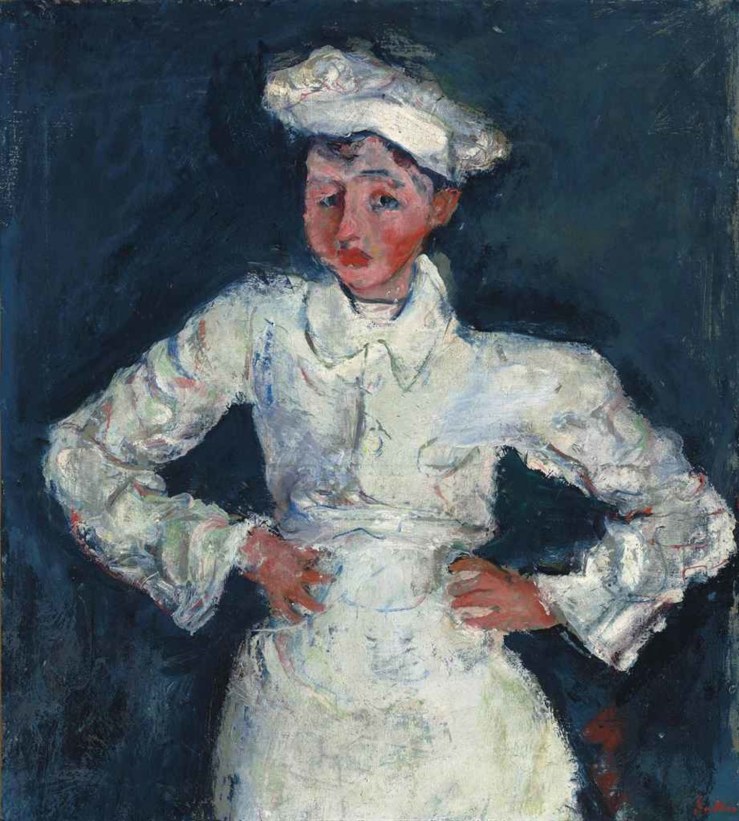
Soutine’s portraits are a different kettle of fish from all his other work—his ‘portraits’ of dead animals, often hung up as if in a butcher’s window, his still-lives which can also have the air of crucifixions, and his tortured landscapes.
The portraits are different because we are less forgiving of liberties taken in representing the ‘human form divine’ (Blake’s piercing phrase). It appears that we have studied the human face more intently than any other aspect of the visible world, as perhaps comes home to us most sharply in front of art.
That is where the limits of an artist’s powers of observation are exposed most cruelly. That is where Soutine’s ‘distortions’ are likeliest to seem arbitrary. He was reputed not to like portraits as a type. Perhaps it is truer to say he didn’t like commissions. He had his own peculiar way of choosing sitters. His preferred subjects are the weak and powerless — children, mad women, the village idiot, a gypsy boy, and the most consistent and fascinating series of all — lowly, serving occupations like pastry cooks, bell-hops and maids — all subjects easily exploited, who weren’t likely to complain that they didn’t like the results, because he was paying them, not the other way around. So these pictures are very different sorts of document from what we usually mean by portraits, and lack the stiffness and falsity common in the form.

In Soutine’s hands even a child with a toy is an uncomfortable idea. Sitting can be a precarious activity in something which doesn’t look like a complete chair. Its top is glued to the child’s head, while its back seems to be trying to unseat him. His toy is another, smaller person falling backward or an angel pointing its wings downward. This is the part where Soutine’s famous abandonment of control in pursuit of the pure freedom of the brush breaks through.

The next sitter is called Mad Woman but has been reduced to childhood by her madness, and wears another elf’s hat, another elf or gremlin not a citizen of the adult world. Soutine’s women are often marked by twisted shoulders, a form of wrenching, involuntary movement. This girl is more completely shrunken into herself through spider-like compression.

The older woman protected by her hat carries a feature almost unheard of in Soutine, an emotive title–Desolation. Would we know she was heartbroken without the prompt? It takes us no time at all to figure that her lopsided shoulders and twisted arms do not mean a disease of the spine but an expressive lunge into an unstable mental state, the real question being whether the unexpected torque is a momentary or an essential condition. It would be a hard pose to hold—Soutine’s people twist from one uncomfortable position to another, but there’s unexpected freedom in the variety.

While Desolation seems normative among Soutine portraits, the picture of his supporter and fellow painter Emile Lejeune stands apart for its light background and sprightly tonalities. The sitter’s relaxed mood seems to have inspired confidence and made Soutine himself temporarily optimistic. We read the dent in Lejeune’s face and his uneven ears as accident rather than meaning, a sign that the artist’s attention was focussed elsewhere, carelessness of a positive kind.

By starkest contrast, darkness gathers round the gypsy boy like a portent. Maybe other observers wouldn’t have read extreme apprehension, vulnerability and the wish to disappear in the deep, dark eyes, but Soutine is alert to them, perhaps because susceptible himself. This picture is usually dated to 1922-3, early for us already to be reading in it signs of what lies in wait for Europe in the following decade.
It isn’t just light and dark tonalities that make the mood in Soutine. This picture of a very young pastry cook is the most tragic member of the most sustained series of Soutine portraits, devoted to a group with whom he has the most perfunctory relations, until he chooses to explore them, the service staff of the cheap hotels and restaurants he frequented in his summers in Cagnes on the south coast.

Another triangular face which shrinks away to nothing, a stillness signifying exhaustion or a complete absence of hope, ears painfully exposed and defenceless features, and the wonderful blankness of all the white, concealing a being erased, with a body made of air, beautiful in its way, with especially delicate lines marking its divisions. The chair suggests the cage of a timid animal.

A jauntier version of the same plight, striking a more assertive pose but paper-thin, and again the strange motif of the red handkerchief like a blood-stain semi-hidden.

This outlying example in the pastry cook series from three or four years earlier cries to be included because it is the Soutine picture that the eccentric collector from Philadelphia, Dr Albert Barnes, saw in a dealer’s window, from which he found his way to Soutine’s studio and bought most of its contents (fifty-plus paintings) on the spot, bringing the painter to much wider attention.
It is the first of the group dressed all in one colour, or no-colour, which breaks out into a whole range of blue, purple, yellow, pink, registering light or recording creases, a crucial moment in Soutine’s attack on the coherence of objects, also seen in the ear that begins talking to its surroundings and finds itself resembling the chair back.

At some time around 1924 or 5, Soutine began to frequent more expensive hotels but continued to enlist the most down-trodden elements of their populations, who sometimes pick up the pretensions of the posher premises, so that this ‘garcon d’honneur’ – a maitre d’ or a room-service waiter? it doesn’t seem clear – is able to sit with no visible means of support through a feat of belief, an acrobat-functionary.

Another bellhop even turns his uniform into an identity, twisting it improbably into an imposing pattern.

The third in this series of arms-akimbo poses – sitting in mid-air, sitting awkwardly, standing uncertainly – defensive and assertive, salvaging a self in unpromising circumstances – looks battered but cocky, and Soutine has again found human depth in unexpected places.

The twists of these three poses say a great deal about the strains of these lives. Even more complex and tortured flexions turn up in female subjects who twist this way and that, misshapen by the stresses of no job, but by the general facts of feminine existence, another, more unwitting mad-woman.

The females among the hotel-staff portraits are the most abject of all, like this lady’s maid who melts, sliding downward, whose indecisive mouth is one of the saddest human features ever painted.

This so-called English girl is one of the lucky ones, who makes a crooked pose into nonchalance.

But best of all is the one most defaced by the painter’s wilful abandon, who drags strength from what should have been ugliness. Like many of his unschooled subjects, she comes out of the battle an unlikely victor, where every error in the symmetry is a bit of hard-won depth. Flesh of horrid orange-pink, clothes of stains and smears, like a surface given life by dirt, yet it’s the serpentine pose that tells us most persuasively that we are rushing somewhere significant, unheard-of till now.
